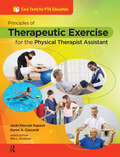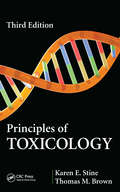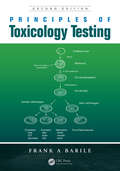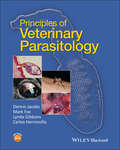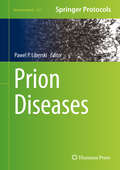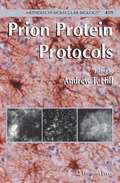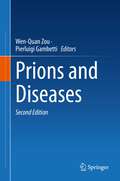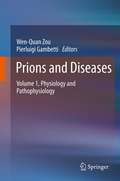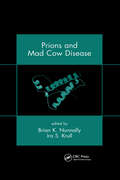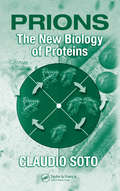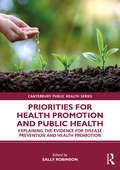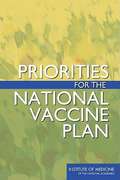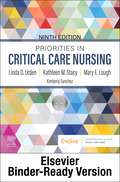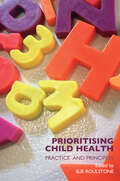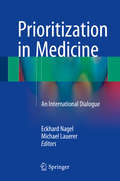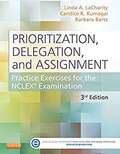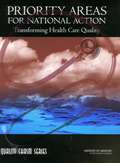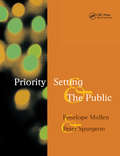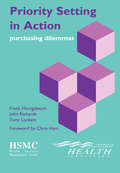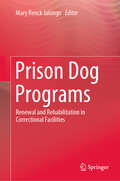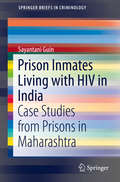- Table View
- List View
Principles of Therapeutic Exercise for the Physical Therapist Assistant (Core Texts for PTA Education)
by Jacqueline Kopack Karen CascardiPrinciples of Therapeutic Exercise for the Physical Therapist Assistant is a textbook that provides PTA educators, students, and practicing clinicians with a guide to the application of therapeutic exercise across the continuum of care.Written by 2 seasoned clinicians with more than 40 years of combined PTA education experience, Principles of Therapeutic Exercise for the Physical Therapist Assistant focuses on developing the learner’s ability to create effective therapeutic exercise programs, as well as to safely and appropriately monitor and progress the patient within the physical therapy plan of care. The content is written in a style conducive to a new learner developing comprehension, while still providing adequate depth as well as access to newer research.Included in Principles of Therapeutic Exercise for the Physical Therapist Assistant are:• Indications, contraindications, and red flags associated with various exercise interventions• Documentation tips• Easy-to-follow tables to aid in understanding comprehensive treatment guidelines across the phases of rehabilitation• Eye on the Research sections throughout the text dedicated to current research and evidence-based practicesAlso included with the text are online supplemental materials for faculty use in the classroom, consisting of PowerPoint slides and an Instructor’s Manual (complete with review questions and quizzes).Created specifically to meet the educational needs of PTA students, faculty, and clinicians, Principles of Therapeutic Exercise for the Physical Therapist Assistant is an exceptional, up-to-date guidebook that encompasses the principles of therapeutic science across the entire continuum of care.
Principles of Toxicology
by Thomas M. Brown Karen E. StineReflecting the broad and interdisciplinary nature of toxicology, this third edition of Principles of Toxicology explores the biochemical, physiological, and environmental aspects of the subject.This new edition is updated and revised to include reference to several major new directions in the science of toxicology, including significant changes in
Principles of Toxicology Testing
by Frank A BarileNationally, toxicology programs have evolved from a traditional exploration of the chemistry and applied toxicity of chemicals and drugs to a more comprehensive study of toxicology and toxicology testing as independent entities. Consequently, the second edition of Principles of Toxicology Testing starts with basic toxicological principles, includin
Principles of Veterinary Parasitology
by Mark Fox Carlos Hermosilla Lynda Gibbons Dennis JacobsPrinciples of Veterinary Parasitology is a student-friendly introduction to veterinary parasitology. Written primarily to meet the immediate needs of veterinary students, this textbook outlines the essential parasitological knowledge needed to underpin clinical practice. Conceptual relationships between parasitic organisms, their biology and the diseases they cause are clearly illustrated. Help boxes and practical tips are included throughout alongside a wealth of colour photographs, drawings and life-cycle diagrams. Organised taxonomically with additional host-orientated chapters and focussing on parasites that commonly cause animal or zoonotic disease, welfare problems or economic losses, students worldwide will benefit from this straightforward and easy to comprehend introduction to veterinary parasitology. Key features include: An easy to navigate textbook, providing information essential for clinical studies Full colour throughout, with photographs, diagrams, life-cycles and help boxes for visual learners A companion website including a pronunciation guide, self-assessment questions and further reading lists
Prion Diseases
by Pawel P. LiberskiThis volume provides comprehensive information and detailed laboratory protocols used in the study of prion diseases. The chapters in this book cover topics such as: electron microscopy, neuropathology, immunohistochemistry, and immune-gold electron microscopy of prion diseases. Chapters also provide readers with detailed information about kuru, the clinical description of prion diseases, and the detection of prion protein and biomarkers. In Neuromethods series style, chapters include the kind of detail and key advice from the specialists needed to get successful results in your laboratory.Cutting-edge and authoritative, Prion Diseases is a valuable resource for researchers and scientists in the exciting and rapidly growing field of prion disease research.
Prion Protein Protocols
by Andrew F. HillWhile much information has been gained regarding the molecular nature of prion proteins, only recently have several research groups begun to cast light on turning the normal prion protein into its aberrant, infectious form. In this book, a team of experts provide the most up-to-date collection of current methods in this unique area of neuroscience. Comprehensive and cutting-edge, this is an ideal collection for researchers investigating the growing field of mammalian prion disease.
Prions and Diseases
by Wen-Quan Zou Pierluigi GambettiTransmissible spongiform encephalopathies (TSE), known as prion diseases, have been recognized for nearly 300 years in animals and almost 100 years in humans. Modern studies, including the protein-misfolding cyclic amplification (PMCA), have greatly advanced our understanding of the pathogenesis of prion diseases and facilitated the identification of new prion diseases in animals and humans. In the second edition of Prions and Diseases, more than 60 leading researchers and clinicians worldwide provide an up-to-date discussion of these unique infectious pathogens and their associated diseases. The book provides up-to-date knowledge about the etiology, pathogenesis, classification, histopathological, and clinical aspects of the full range of animal and human prion diseases. As a result, the book contains by far the most authoritative views about the past, present, and future of prions and prion diseases. The new second edition covers such important emerging topics such as inherited human prion disease, stem-cell models in prion research, human prion disease surveillance, and gene therapy strategies.
Prions and Diseases: Volume 1, Physiology and Pathophysiology
by Wen-Quan Zou Pierluigi GambettiVolume I highlights the association of the cellular prion protein (PrPC) with copper and zinc, the potential roles of PrPC in Alzheimer's disease and cancers, insoluble PrPC, PMCA, molecular and cellular mechanisms of PrPSc formation and clearance, possible co-factors involved in the conversion of PrPC into PrPSc, infectious and pathogenic forms of PrP, cell biology of prions, prion strains and their interference, as well as yeast prions and their inheritable and structural traits. This unique volume will take you through the fascinating chronicle of prions in mammals, yeast, and fungi.
Prions and Diseases: Volume 2, Animals, Humans and the Environment
by Wen-Quan Zou Pierluigi GambettiVolume II features a variety of animal and human prion diseases, including the newly-identified atypical forms of bovine spongiform encephalopathy and scrapie in animals, and variably protease-sensitive prionopathy in humans, prions in the environment, Tau pathology in human prion disease, transmission of the disease by blood transfusion, mammalian and non-mammalian models, conventional and advanced diagnoses, prion-specific antibodies, as well as decontamination of prions and development of therapeutics of prion diseases, such as the application of immunomodulation. This volume provides up-to-date knowledge about the etiology, pathogenesis, classification, histopathological, and clinical aspects of the highly publicized animal and human prion diseases.
Prions and Mad Cow Disease
by Brian K. Nunnally Ira S. KrullThe alarm sounded by Canada's confirmed case of bovine spongiform encephalopathy (BSE) has reaffirmed the exigency of establishing improved safeguards and more aggressive surveillance protocols in North America and around the world. Research converging on the probable causative agent--prion proteins--calls for intensive assessment of the headway gained in tracing prions, testing for transmissible neurodegenerative diseases, and developing methods for cornering the epidemic. With an illustrious panel of 36 international contributors, this timely book marshals techniques for prion protein assay and diagnosis of transmissible spongiform encephalopathies (TSEs).
Prions: The New Biology of Proteins
by Claudio SotoPrion-related diseases, known as transmissible spongiform encephalopathies (TSEs), are infectious, fatal neurodegenerative disorders for which there is no cure, treatment, nor even a means for early diagnosis. The horrific advent of Mad Cow Disease -- transmitted to humans through eating meat from steers sickened by bovine spongiform encephalopathy
Priorities for Health Promotion and Public Health: Explaining the Evidence for Disease Prevention and Health Promotion (Canterbury Public Health Series)
by Sally RobinsonPriorities for Health Promotion and Public Health brings together the evidence behind the UK’s public health priorities into one comprehensible textbook. Taking one theme per chapter, the book examines the social and environmental influences that shape people’s health; health inequalities; poverty and health; mental, emotional and spiritual health; sexual health; physical inactivity; diet; tobacco; alcohol; drugs; weight; cardiovascular disease; cancer; diabetes and dementia. The book takes a holistic approach, combining scientific and epidemiological evidence with the subjective experiences of those who undergo these health journeys. Each chapter explains the causes of poor health and the evidence behind the recommendations for good health and ends by demonstrating the health benefits of positive action. This is a core text for those studying health promotion or public health, and a supplementary text for students of healthcare and social care. The book focusses on adults’ health in the UK, with examples from the four nations, and provides some contextual international information where relevant. Priorities for Health Promotion and Public Health is an ideal companion for busy practitioners who work across the wider sectors that support people’s health and wellbeing. It is also an essential textbook for students new to health promotion and public health.
Priorities for the National Vaccine Plan
by Institute of Medicine of the National AcademiesVaccination is a fundamental component of preventive medicine and public health. The use of vaccines to prevent infectious diseases has resulted in dramatic decreases in disease, disability, and death in the United States and around the world. The current political, economic, and social environment presents both opportunities for and challenges to strengthening the U.S. system for developing, manufacturing, regulating, distributing, funding, and administering safe and effective vaccines for all people. Priorities for the National Vaccine Plan examines the extraordinarily complex vaccine enterprise, from research and development of new vaccines to financing and reimbursement of immunization services. Priorities for the National Vaccine Plan examines the extraordinarily complex vaccine enterprise, from research and development of new vaccines to financing and reimbursement of immunization services. The book makes recommendations about priority actions in the update to the National Vaccine Plan that are intended to achieve the objectives of disease prevention and enhancement of vaccine safety. It is centered on the plan's five goals in the areas of vaccine development, safety, communication, supply and use, and global health.
Priorities in Critical Care Nursing
by Mary E. Lough Linda D. Urden Kathleen M. Stacy Kimberly SanchezFocus on the most important concepts in progressive and critical care nursing with Priorities in Critical Care Nursing, 9th Edition. Ideal for students, practicing nurses undergoing in-service training for progressive and critical care, and progressive or critical care nurses reviewing for PCCN® or CCRN® certification, this trusted, evidence-based textbook uses the latest, most authoritative research to help you identify patient priorities in order to safely and expertly manage patient care. Succinct coverage of all core progressive and critical care nursing topics includes medications, patient safety, patient education, problem identification, and interprofessional collaborative management. You will learn how to integrate the technology of progressive and critical care with the physiological needs and psychosocial concerns of patients and families to provide the highest-quality care.
Prioritising Child Health: Practice and Principles
by Sue RoulstonePrioritisation exists throughout healthcare. Difficult and controversial decisions are frequently made at national, local and service level, as well as on an individual basis. However, attention has generally been focused away from the practitioners and service managers who make day-to-day prioritising decisions in order to manage their workloads and deliver front-line services. Focusing on child health contexts, Prioritising Child Health opens up the debate on prioritisation by individuals and explores the issues surrounding their decisions. Grounded in the reality of everyday life, it encourages the reader to make their own judgements about how to prioritise. It will appeal to professionals working in child health, including speech and language therapists, occupational therapists and physiotherapists, as well as nurses, doctors and health visitors.
Prioritization in Medicine
by Eckhard Nagel Michael LauererThe gap between a rising demand for health care services on the one side and scarce resources on the other, is leading to a growing pressure on decision-making processes. Hence, prioritization in medicine has become an increasingly important issue for assuring stability of health systems and improving the capability of health care. The present volume addresses normative dimensions of methodological and theoretical approaches, the legal basis behind priority setting as well as international experiences concerning the normative framework and the process of priority setting. It also examines specific criteria for prioritization and discusses economic evaluations. Contributing authors from a broad range of scientific disciplines discuss prioritization within an international dialogue.
Prioritization, Delegation, And Assignment: Practice Exercises For The NCLEX Examination
by Candice K. Kumagai Linda A. LaCharity Barbara BartzThe only NCLEX review book on the market with a focus on prioritization, delegation, and patient assignment ? just like the current NCLEX Examination itself! Using a unique simple-to-complex approach, Prioritization, Delegation, and Assignment: Practice Exercises for the NCLEX® Examination, 3rd Editionestablishes your foundational knowledge in management of care, then provides exercises of increasing difficulty to help you build confidence in your prioritization, delegation, and patient assignment skills. "..certainly a great resource for use in any healthcare setting." Reviewed by Anne Duell on behalf of Nursing Times, September 2015 <P><P> UNIQUE! Emphasis on the NCLEX Examination’s management-of-care focus addresses the heavy emphasis on prioritization, delegation, and patient assignment in the current NCLEX Examination (17–23% of the 2013 NCLEX-RN Exam). UNIQUE! Three-part organization establishes foundational knowledge and then provides exercises of increasing difficulty to help you build confidence in your prioritization, delegation, and patient assignment skills. Answer key at the back of the book offers a detailed rationale and an indication of the focus of the question to encourage formative assessment. Introduction chapter by delegation expert Ruth Hansten provides guidelines for prioritization, delegation, and patient assignment decisions as well as a concise, practical foundation on which Parts 2 and 3 build. Part 2: Prioritization, Delegation, and Assignment in Common Health Scenarios give you practice in applying the principles from Part 1 with straightforward NCLEX-style multiple-choice, multiple-select, ordering, and short-answer questions to help you develop and build confidence in prioritization, delegation, and patient assignment skills while working within the confines of relatively simple health scenarios. Part 3: Prioritization, Delegation, and Assignment in Complex Health Scenarios utilizes unfolding cases that build on the skills learned in Part 2 to equip you to make sound decisions in realistic, complex health scenarios involving complicated health problems and/or challenging patient assignment decisions and help you learn to "think like nurses" by developing what Benner (2010) calls "clinical imagination."
Prioritization, Delegation, and Assignment: Practice Excercises for the NCLEX Exam
by Candice K. Kumagai Linda A. LaCharity Shirley M. HoslerPrepare for the Next-Generation NCLEX-RN® Exam (NGN) and gain the clinical judgment skills you need to manage patient care safely and effectively! Prioritization, Delegation, and Assignment: Practice Exercises for the NCLEX-RN® Examination, 5th Edition is the first and the most popular NCLEX-RN Exam review book focused exclusively on building management-of-care clinical judgment skills. What’s more, this bestselling review is now enhanced for the NGN with new NGN-style questions! Beginning with concepts relating to prioritization, delegation, and assignment decisions, the workbook guides you through patient care scenarios and exercises progressing from simple to complex. All of the book’s questions are provided in an interactive online format on the Evolve website in tests that simulate the latest NCLEX-RN Exam. Written by a team of noted educators led by Linda A. LaCharity, this review prepares you for success on the NGN and in clinical practice like no other! <p><p> Management-of-care focus addresses the emphasis on prioritization, delegation, and patient assignment in the NCLEX-RN® Examination. <p><p> Three-part organization first establishes foundational knowledge and then provides exercises with scenarios of increasing difficulty to help you build confidence in your prioritization, delegation, and patient assignment skills. <p><p> Part One: Introduction provides a concise foundation and practical guidelines for making prioritization, delegation, and patient assignment decisions. <p><p> Part Two: Prioritization, Delegation, and Assignment in Common Health Scenarios provides practice in applying the principles you’ve learned to relatively straightforward health scenarios involving single patients or simple patient assignments. <p><p> Part 3: Prioritization, Delegation, and Assignment in Complex Health Scenarios includes unfolding cases involving patients with progressively more complicated health problems or challenging assignment issues, demonstrating the progression of typical health scenarios and helping you learn to "think like a nurse." <p><p> Answer keys follow each chapter and provide the correct answer plus a detailed rationale. <p><p> Practice quizzes on the Evolve website include all of the book’s questions in an interactive format that allows you to create a virtually unlimited num
Priority Areas for National Action: Transforming Health Care Quality
by Committee on Identifying Priority Areas for Quality ImprovementThe National Academies Press (NAP)--publisher for the National Academies--publishes more than 200 books a year offering the most authoritative views, definitive information, and groundbreaking recommendations on a wide range of topics in science, engineering, and health. Our books are unique in that they are authored by the nation's leading experts in every scientific field.
Priority Setting Processes for Healthcare: In Oregon, USA; New Zealand; the Netherlands; Sweden; and the United Kingdom
by Frank HonigsbaumIn the face of the relentless rise in health costs, many countries have had to set priorities so that maximum benefit can be made of unlimited funds. This book shares the experience of those which have taken a lead in this field, and draws on models being developed in Oregon, New Zealand, The Netherlands and Sweden as well as the UK. It discusses the strengths and weaknesses of each system from which healthcare planners and managers can draw their own conclusions and apply to the situation for which they are responsible.
Priority Setting and the Public
by Peter Spurgeon Penelope MullenPractical and evidence-based, this unique book is the first comprehensive text focused on person-centered approaches to people with serious mental illness such as schizophrenia and bipolar disorder. It reflects a range of views and findings regarding assessment, treatment, rehabilitation, self-help, policy-making, education and research. It is highly recommended for all healthcare professionals, students, researchers and educators involved in general practice, psychiatry, nursing, social work, clinical psychology and therapy. Healthcare service providers, and policy makers and shapers, will find the book's wide-ranging, multi-professional approach enlightening. 'Serious Mental Illness reflects a continued distancing from the outmoded and unsubstantiated belief that people with severe mental illnesses could not recover, and that they would respond positively only to goals and treatment plans chosen, designed and implemented by providers in order to prevent their further deterioration. Anyone with an interest in the concept of person-centered approaches will discover new ideas in this book. Indeed, anyone with an interest in person-centered approaches has to read this book. Not only is it the first such book on person-centered approaches, but it will serve as the gold standard in this topic area for years to come.' William A Anthony, in the Foreword
Priority Setting in Action: Purchasing Dilemmas
by John Richards Chris Ham Frank HonigsbaumThe power of purchasers exposes the weaknesses of conventional thinking on the costs and benefits of priorities. Health policy analysts now have to develop rational criteria to support decisions in a process which may be inherently intuitive. This authoritative and practical text points the way towards clear choices in resource allocation and the implications of these choices on expenditure diverted among different health care programmes.
Prison Dog Programs: Renewal and Rehabilitation in Correctional Facilities
by Mary Renck JalongoThis edited volume brings together a diverse group of contributors to create a review of research and an agenda for the future of dog care and training in correctional facilities. Bolstered by research that documents the potential benefits of HAI, many correctional facilities have implemented prison dog programs that involve inmates in the care and training of canines, not only as family dogs but also as service dogs for people with psychological and/or physical disabilities. Providing an evidence-based treatment of the topic, this book also draws upon the vast practical experience of individuals who have successfully begun, maintained, improved, and evaluated various types of dog programs with inmates; it includes first-person perspectives from all of the stakeholders in a prison dog program—the corrections staff, the recipients of the dogs, the inmate/trainers, and the community volunteers and sponsors Human-animal interaction (HAI) is a burgeoning field of research that spans different disciplines: corrections, psychology, education, social work, animal welfare, and veterinary medicine, to name a few. Written for an array of professionals interested in prison dog programs, the book will hold special interest for researchers in criminal justice and corrections, forensic psychology, and to those with a commitment to promoting the ideals of rehabilitation, desistance thinking, restorative justice, and re-entry tools for inmates.
Prison Food: Identity, Meaning, Practices, and Symbolism in European Prisons (Palgrave Studies in Prisons and Penology)
by An-Sofie VanhoucheBased on the lived experiences of incarcerated persons and staff, this book explores the symbolic significance of prison foodways to normalization, autonomy, identity construction, power, group formation and security. The book also traces the rationalization(s) that policy makers attach to prison food, from the water and bread diet of the 18th century, the contested abolition of alcohol consumption, to the current fear surrounding the spread of COVID-19 through food distribution in prisons. The argument is developed that prison food policies have always reflected how Belgian governments have treated imprisoned persons. The emphasis on Belgian prisons and the discussions on prison foodways situated on a micro and macro level add a unique flavour to prison food scholarship by providing a deeper understanding of a penal culture outside the dominant tradition of Anglo-Saxon and Nordic studies. Consequently, the book provides a nuanced conception of prison foodways for penologists, sociologists, those with interests in wider prison policy, and those working on the socio-cultural role of food in closed environments.
Prison Inmates Living with HIV in India
by Sayantani GuinThis Brief presents preliminary findings from research in three prisons in Maharashtra, India on experiences of prison inmates there living with HIV. The study explores health care services in these prisons, and problems experienced by inmates in India living with HIV, as well as their staff and caregivers. Through this preliminary study, the researchers shed light on the experiences of inmates in Indian prisons, with an aim of presenting questions for future research. The author provides an overview of the global conditions of prison inmates living with HIV, as an international comparative context for examining the cases in India. Major problems highlighted in the cases include: living conditions, high risk behavior during incarceration, delivery of medical services and adherence to ethical guidelines. Results of the study reveal that overcrowding and inadequate nutrition were major concerns for inmates living with HIV; there were no support systems available inside the prisons to address the stress related issues of the inmates; and, the prison hospital did not have provisions to cater to the treatment needs of inmates living with AIDS. The study also found that confidentiality regarding the HIV positive status could not be maintained inside the prison. This Brief presents a window into the experience of inmates in India, and presents questions for future research to understand and improve living conditions and medical service delivery within the prison system. This work will be of interest to researchers in criminology and criminal justice, particularly interested in incarceration or health issues, public health and related areas such as public policy, international studies, and demography studies in India.
